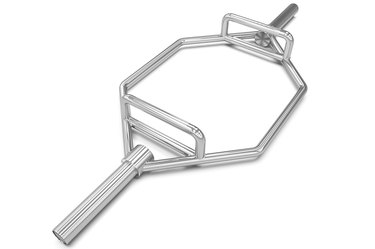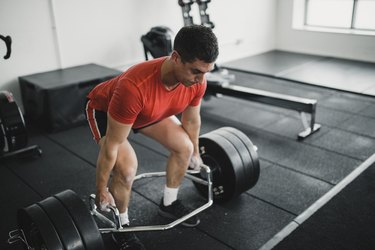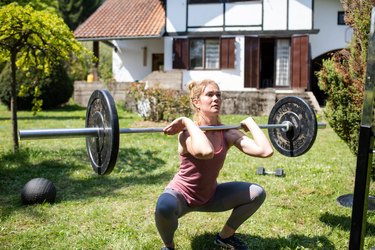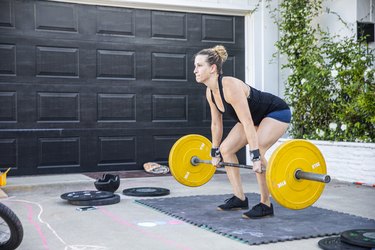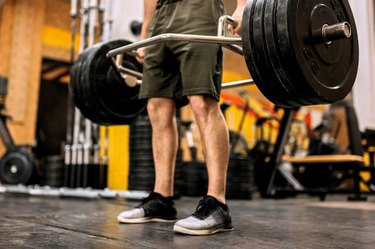
If you've ever seen gym-goers standing inside odd-shaped barbells (known as trap or hex bars) and wondered what the big deal was, we've got you covered.
Here, we give you the lowdown on the trap bar — plus some of the best trap bar exercises to get you started.
Video of the Day
What's a Trap Bar, Anyway?
A trap bar — also called a hex bar — is a little different from the traditional barbells you might usually see in the gym. While a standard or Olympic barbell is a long, straight bar, the aptly named hex bar (HB) is a six-sided hexagon-shaped barbell with a raised handle on each side.
The hexagon shape creates a gap for you to stand inside of when lifting. This brings the weight closer to your center of gravity. Meanwhile, the handle placement also changes the position of your hands during trap bar exercises, says Kasey Kotarak, CPT, a certified personal trainer and coach at Fit Body Boot Camp in Michigan.
"While using a hex bar, your hands on either side of you, your grip is neutral, palms facing in," she says. But with a traditional barbell, your hands are in front of you, palms facing you (overhand/pronated grip), the away from you (underhand/supinated grip) or both (mixed grip).
How Much Does a Trap Bar Weigh?
Like barbells, trap bars (TBs) are available in different types and weights. The three main types are the Gerard trap bar, conventional trap bar and extra-large (XL) trap bar.
Most gyms' TBs are Gerard bars and weigh 45 pounds, but don't assume. Ask your gym staff what type of hex bars it has. Here's how much each type weighs:
Trap/Hex Bar Weights
Kilograms | Pounds | |
|---|---|---|
Gerard | 20 | 45 |
Conventional | 13.3 | 30 |
XL | 25 | 55 |
Why Use a Trap Bar?
The hex bar is a great tool for barbell exercises like deadlifts or bent-over rows because it allows you to work and move your body in slightly different ways than you can with a straight barbell, says Caroline Juster, CPT, a Chicago-based certified personal trainer.
For example, when doing standing exercises with a hex, you're surrounded by the bar — so the weight you're lifting is closer to your center of gravity. That means that you can lift more weight, and will less stress going to your back and spine.This can be especially helpful when learning exercises like the deadlift, as traditional barbells are usually less forgiving of form slip-ups, Kotarak says.
Plus, many people find the TB is simply more comfortable than a traditional barbell. Its hexagonal shape means it won't rub against your shins during deadlifts. And the bar's high, neutral handles make it easier to reach, grip and stabilize.
All in all, the TB tends to be the more comfortable option for people who are tall, have long legs, or shoulder discomfort with regular barbell deadlifts and squats.
The HB is best suited for floor and waist-level lifts like deadlifts, farmer's walks, floor presses and shoulder shrugs, according to William P. Kelley, DPT, CSCS, a physical therapist, certified strength and conditioning specialist and owner of Aries Physical Therapy. (FYI, they're often called "trap bars" because people like to use them to work their upper traps with shoulder shrugs.)
For most every other exercise, there are better options. For example, overhead exercises (like shoulder presses) can be risky with a HB. "You're contained within a small space and surrounded by metal when using the hex bar," he says. "Throwing it around overhead is asking for trouble." Stick to dumbbells, straight bars and kettlebells when working overhead. It's easier to get out of their way, should they fall.
The Best Trap Bars for Your Home Gym
- Sunny Health & Fitness Olympic Hex Bar (Amazon.com, $116.99)
- Synergee Olympic Hex Barbell (Amazon.com, $229.95)
- Rogue TB-2 Trap Bar (Roguefitness.com, $395)
How to Use a Trap Bar
Using a hex bar isn't too different from using a traditional barbell. That said, if you're new to this style of bar, you may appreciate a few pointers. Namely, the best method for loading it..
If you struggle with wrangling weight plates onto a bar, try this trick: Put one weight plate on the bar, and then roll that side up onto a 5-pound plate. Repeat on the other side. "Now you can load the rest of your plates with that slight bit of elevation so they don't rub on the floor," Kelley says.
To keep the weight plates from falling off or moving around while you're using the TB, secure them with collars (most gyms have these near power racks). It's now safe to roll the bar off the 5-pound plates and proceed with your lift.
When you're done, simply roll the bar back up onto the plates and reverse the process to unload, he says.
Just also recommends always loading bumper plates first. These are usually made of high-density rubber so you can drop them on a gym floor without causing noise or damage. "Bumper plates are big and round, as opposed to plates with flat edges and corners, which makes it easier to roll the bar on the floor and load or unload additional plates," she says.
Tip
As with any new exercise or piece of equipment, it’s important to start slow, Kotarak says. So, opt for a lighter weight than you might normally use and spend some time getting comfortable with the HB.
While you’re getting comfortable with the bar at a lighter weight, be sure to focus on your form. “Every exercise has certain things to look out for,” she says. Enlist help from a certified personal trainer if needed.
And finally, take care not to trip or bang your shin when stepping in and out of the bar.
The 4 Best Trap Bar Exercises
Now that you know what the bar is and why you would use it, you're probably wondering what you should do with it. Here are some foundational trap bar exercises — demoed by Juster — to get you started.
For a full workout, simply do the exercises in order. Kotarak recommends doing 3 to 4 sets of 8 to 12 reps for the trap bar deadlifts, bent-over rows and floor presses, and carrying the bar for 3 to 4 60-second walks.
Move 1: Trap Bar Deadlift
- Stand in the center of a trap/hex bar with your feet hip-width apart, toes facing forward.
- Keeping your back as flat as you can, bend your knees slightly, push your hips back and bend forward from your hips to reach down and grip the handles. Keep your shoulders back and down, and your neck neutral.
- Press through your feet and squeeze your glutes as you stand up with the weight as tall as possible. Keep your gaze a few feet in front of you.
- Return the weight to the floor and repeat.
Move 2: Trap Bar Bent-Over Row
- Stand in the center of a trap/hex bar with your feet between hip- and shoulder-width apart, toes facing forward.
- Keeping your back as flat as you can, bend your knees slightly, push your hips back and bend forward from your hips to reach down and grip the handles. Keep your shoulders back and down, and your neck neutral.
- While still in a hip hinge position, lift the weight off the floor and pull your elbows back past your ribcage. Squeeze your shoulder blades together at the top.
- Release your shoulder blades and extend your arms to return to the starting position. Repeat.
- Keep your back flat, shoulders back and eyes toward the ground so your head and neck stay aligned with your spine.
Move 3: Trap Bar Floor Press
- Lie on your back with your knees bent and feet hip-width apart on the floor. Place the lightly loaded trap/hex bar next to you.
- Grip the bar (you can grip the handles that are in line with the bar or the raised handles) and hold the bar right over your chest. Brace your core.
- Then, press the bar above your chest until your arms are fully extended. Don’t lock out your elbows.
- Lower the bar until the backs of your arms make contact with the floor. Repeat.
Move 4: Trap Bar Farmer's Walk
- Stand in the center of a trap/hex bar with your feet hip-width apart.
- Bend forward with a flat back and lift the weight off the floor.
- Keeping your core braced and your steps controlled, begin walking.
- If your back rounds, or you sway from side-to-side while you walk, choose a lighter weight.
